![]() WARNING: GRAPHIC IMAGES IN THIS ARTICLE
WARNING: GRAPHIC IMAGES IN THIS ARTICLE
“If they become tired or even die, that does not matter. Let them die in childbirth – that is why they are there.”
Martin Luther (Von Ebelichen Leben 1522)
The above quote defines the Catholic Church’s and the “pro-life” movement’s view of women. In short they see women as a means to an end, rather than ends in themselves.
On May 16, 2004, Pope John Paul II, canonized Dr Gianna Beretta Molla, a pediatrician/gyn. who died in 1962, aged 39, a week after giving birth to her fourth child. Gianna was the tenth of 13 children and studied medicine and surgery at the University of Pavia. Upon completing her studies she opened a clinic at Mesero and specialised in treating pregnant women, babies and the poor. She married Pietro Molla in 1955 and bore three children in the next four years. When she became pregnant with her fourth child in 1961, she was diagnosed with womb cancer at the second month of pregnancy. Her doctor recommended that she have surgery to save her life which would have resulted in the termination of the pregnancy. Gianna refused. She would only agree to an operation only if did not endanger the foetus so she ended up having surgery to remove the tumour and nothing else done. She knew that her “choice” was likely to end her life and therefore leaving her three already born children without a mother. Although she suffered terrible abdominal pain, she refused pain relief as she believed it was not proper to appear before God without much suffering.
Gianna’s view on abortion was in line with Catholic Church doctrine:
“The doctor should not meddle. The right of the child to live is equal to the right of the mother’s life. The doctor cannot decide; it is a sin to kill in the womb.”
When she was approached by someone wanting an abortion, she refused and told them that this was a grave offence against God:
“If one were to consider how much Jesus suffered, one would not commit the smallest sin.”
Some people have rightly criticized the choice Gianna made because it suggests that the embryo/foetus has more value than the life of a woman – a big issue in the US where George W. Bush and the “pro life” Taliban are striving to ensure full rights to fertilized eggs, embryos and foetuses at the expense of women’s health and lives.
Let’s stop and ponder if Gianna’s choice was truly her own. Having been brought up as a strict Catholic and being actively involved with Catholic organisations, would have ensured that the doctrine of abortion and contraception as grave sins were firmly embedded in her mind and constantly reiterated with her closeness with the Catholic Church. The indoctrination must have been so strong that she was willing to leave orphaned her three children under the age of five, rather than disobey Catholic doctrine. Had Gianna not been a strict Catholic, would her choice have been different?
We must bear in mind that anyone with extreme religiosity such as Gianna’s would not dream of ever disobeying religious absolutes, that of course applies to all religions, not just Catholicism. E.g. the perpetrators of September 11 believed they were doing their god’s work when they flew the passenger planes into the twin towers – would they have taken the same action had it not been for religious indoctrination? I think not!
Let’s look at the vast differences between the feminist pro-choice view and the “pro-life” view:
PRO CHOICE:
Women faced with an unwanted pregnancy have two choices,
a) They can terminate the pregnancy.
b) Allow the pregnancy to continue, have the baby, keep it or place it up for adoption which is an acceptable option for some but not all women. Many people find the idea of forced pregnancy and forced abortion equally abhorrent – we only need to look at the situation of women in China and India where women are forced by their families to abort female foetuses. Therefore, whatever a woman’s decision is, her wishes are respected. Indeed, many women choose to continue unplanned pregnancies, I see nothing wrong with that choice, and I believe that they should be given all the support that they need.
“PRO-LIFE”:
Here a woman has no option but to continue the pregnancy regardless of the risks to health and life, financial difficulties, very young age, family problems or inability to care for more children. It makes no difference if the pregnancy resulted from rape/incest, or whether the woman is living in poverty with several children to look after. “Pro-lifers” also oppose birth control, sex education and emergency contraception, even for rape victims. They have total disregard for women’s lives as the following account clearly shows:
In 1984, Angela Carder was struck with lung cancer while pregnant. She was hospitalised and her doctor recommended radiation and chemotherapy. Angela made it clear that she wanted her health to come first. But the doctors at the hospital had given Angela only days to live and would not prescribe chemotherapy because they feared it would endanger the foetus. The foetus was twenty-six weeks and if they could prolong Angela’s life for three more weeks – instead of trying to save it – the foetus would have a better chance. Instead of treating her cancer, they inserted a tube down her throat and pumped her with sedatives in order to delay her death. According to her mother, Angela thrashed and twisted on the bed trying to fend off the doctors but with the tube in her throat her battle was in vain.
The administration of the George Washington Hospital feared that they might be taken to court by anti-abortionists for failing to save the foetus. The administration proposed that a caesarean section be performed in order to save the foetus. The hospital’s doctors opposed the surgery since it would probably kill Angela. Angela was unconscious from the sedatives and rather than waiting a few hours for the drugs to wear off so they could ask her permission, the hospital administration called in a judge.
During the hearing the foetus’s lawyer Barbara Mishkin said: “Well I suppose it will hasten her death but Angela is probably going to die in a few hours anyway. Her rights should be put aside.”
The judge wanted to know how a caesarean would affect the health of the foetus but not how it would affect Angela. At the end he told the doctors to operate immediately.
The doctors delivered a girl; repeated efforts to inflate her lungs with a respirator were unsuccessful. Angela slipped into a coma and died two days later.
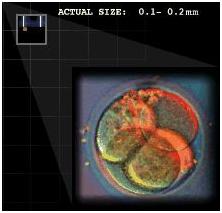
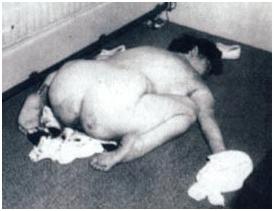
For “pro-lifers” the dividing cells in the picture above have far more value than the woman on the right.
The woman in the photo is Gerri Santoro, dead after a botched abortion. In 1964, at the time of her lonely death, Gerri was a mother of two and abortion was a criminal act.
The photo first appeared in MS Magazine in April 1973.
The late, great Carl Sagan had this to say:
“If you deliberately kill a human being, it’s called murder. If you deliberately kill a chimpanzee – biologically, our closest relative, sharing 99.6 percent of our active genes – whatever else it is, it’s not murder. To date, murder uniquely applies to killing human beings. Therefore, the question of when personhood (or, if we like, ensoulment)arises is key to the abortion debate. When does the foetus become human? When do distinct and characteristic human qualities emerge?
We recognize that specifying a precise moment will overlook individual difference. Therefore if we must draw a line, it ought to be drawn conservatively – that is, on the early side. There are people who object to having to set some numerical limit, and we share their disquiet; but if there is to be a law on the two absolutist positions, it must specify, at least roughly, a time of transition to personhood.
Every one of us began from a dot. A fertilized egg is roughly the size of the period at the end of this sentence. The momentous meeting of sperm and egg generally occurs in one of the two fallopian tubes. One cell becomes two, two become four and so on – an exponentiation of base-2 arithmetic. By the tenth day the fertilized egg has become a kind of hollow sphere wandering off to another realm: the womb. It destroys tissue in its path. It sucks blood from capillaries. It bathes itself in maternal blood, from which it extracts oxygen and nutrients. It establishes itself as a kind of parasite on the walls of the uterus.
By the third week, around the time of the first missed menstrual period, the forming embryo is about two millimeters long and is developing various body parts. Only at this stage does it begin to be dependent on a rudimentary placenta. It looks a little like a segmented worm. (A number of right-wing and Christian fundamentalist publications have criticized this argument – on the grounds that it is based on an obsolete doctrine, called recapitulation. The comparisons of the human foetus with other animals is based on the appearance of the foetus. Its non-human form, and nothing about its evolutionary history, is the key to the argument of these pages.)”
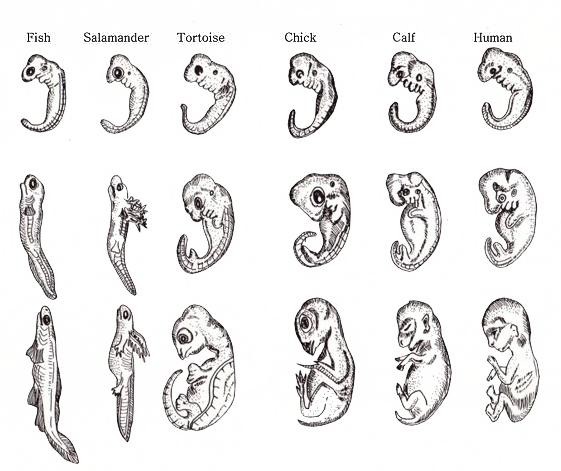
Animal and human embryos at three stages of development. Source: “The Facts of Life”
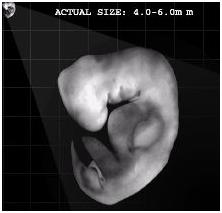
Human embryo at 28 days after conception
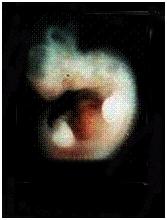
Rat embryo at day 14 of gestation
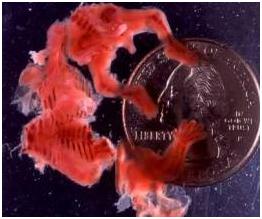
Image of aborted foetus at 8 weeks
If the image was of a chimpanzee foetus would the “pro-lifers” be at all concerned for it’s welfare?
Would the photo then be any less graphic? The photos of foetuses on “pro-life” sites are always of stages where the foetus acquires human physical appearance. It would not be surprising if they use photos of more developed foetuses and pass them off as earlier ones.
Remember, these are the people who insist that condoms have tiny holes in them which allow the entry of the HIV virus.
“By the end of the fourth week, it’s about five millimeters (about a fifth on an inch) long. It’s recognisable now as a vertebrate, its tube-shaped heart is beginning to beat, something like the gill arches of a fish or an amphibian become conspicuous, and there is a pronounced tail. It looks rather like a newt or a tadpole. This is the end of the first month after conception.
By the fifth week, the gross divisions of the brain can be distinguished. What will later develop into eyes are apparent, and little buds appear – on their way to becoming arms and legs.
By the sixth week, the embryo is thirteen millimeters (about half an inch) long. The eyes are still on the side of the head, as in most animals, and the reptilian face has connected slits where the mouth and nose eventually will be.
By the end of the seventh week, the tail is almost gone, and sexual characteristics can be discerned (although both sexes look female). The face is mammalian but somewhat piglike.”
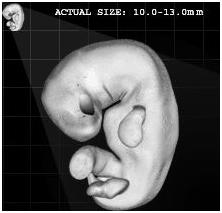
Human embryo at about 40 days after conception
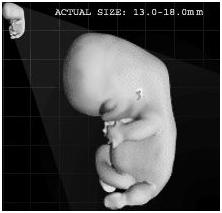
Human embryo at about 48 days after conception
(Images of developing embryos from: http://www.visembryo.com/baby)
“By the end of the eighth week, the face resembles that of a primate but is still not quite human. Most of the human body parts are present in their essentials. Some lower brain anatomy is well developed. The foetus shows some reflex response to delicate stimulation.
By the tenth week, the face has an unmistakably human cast. It is beginning to be possible to distinguish males from females. Nails and major bone structures are not apparent until the third month.
By the fourth month, you can tell the face of one foetus from that of another. Quickening is most commonly felt in the fifth month. The bronchioles of the lungs do not begin developing until approximately the sixth month, the alveoli still later.
So, if only a person can be murdered, when does the foetus attain personhood?
When its face becomes distinctly human, near the end of the first trimester?
When the foetus becomes responsive to stimuli – again, at the end of the first trimester?
When it becomes active enough to be felt as quickening, typically in the middle of the second trimester?
When the lungs have reached a stage of development sufficient that the foetus might, just conceivably, be able to breathe on its own in the outside air?
The trouble with these particular developmental milestones is not just that they’re arbitrary. More troubling is the FACT that none of them involves uniquely human characteristics – apart from the superficial matter of facial appearance. All animals respond to stimuli and move of their own volition. Large number are able to breathe. But that doesn’t stop us from slaughtering them by the billions. Reflexes and motion and respiration are not what make us human.
Other animals have advantages over us – in speed, strength, endurance, climbing or burrowing skills, camouflage, sight, smell or hearing, mastery of the air or water. Our one great advantage, the secret of our success, is though – characteristically human thought. We are able to think things through, imagine events yet to occur, figure things out. That’s how we invented agriculture and civilization. Thought is our blessing and our curse, and it makes us who we are.
Thinking occurs, of course, in the brain – principally in the top layers of the convoluted ‘grey matter’ called the cerebral cortex. The roughly 100 billion neurons in the brain constitute the material basis of thought. The neurons are connected to each other, and their linkups play a major role in what we experience as thinking. But large-scale linking up of neurons doesn’t begin until the twenty-fourth to twenty-seventh week of pregnancy – the sixth month.
By placing harmless electrodes on a subject’s head, scientists can measure the electrical activity produced by the network of neurons inside the skull. Different kinds of mental activity show different kind of brain waves. But brain waves with regular patterns typical of adult human brains do not appear in the foetus until about the thirtieth week of pregnancy – near the beginning of the third trimester. Foetuses younger than this – however alive and active they may be – lack the necessary brain architecture. They cannot yet think.”
Excerpt from:
“Billions and Billions”, (pages 176 to 180) by Carl Sagan, first published in 1997 by HEADLINE BOOK PUBLISHING, ISBN0-7472-5792-2
FACT
Emergency contraceptives (morning after pills), hormonal contraceptives and IUD’s are highly effective in preventing pregnancy and therefore the need for abortion.
FACT
The vast majority of abortions, approximately 90%, occur during the first trimester.
FACT
Early chemical abortions with RU486 can only be used within the first 6-7 weeks of pregnancy.
FACT
World Health Organization estimates that around 550 women die every day from attempts to end unwanted pregnancies.
FACT
CONDOMS ARE PRO-LIFE: they prevent AIDS and unwanted pregnancies.
FACT
The “pro-life” alliance also opposes modern birth control methods, condoms for the prevention of AIDS, emergency contraception, and accurate, comprehensive sex education.
FACT
Anti-abortion laws do not eliminate abortion, they merely make it unsafe. Those of you who do not remember the days before ‘Roe vs Wade’, should take note of the plight of women in developing countries where abortion is illegal or inaccessible.
The link below is for a case where a woman was forced to bear an anencephalic baby, that is a baby with no forebrain – the main part of the cerebrum, responsible for thinking and coordination. Anencephalic babies are born unconscious and insensitive to pain. Without a functioning cerebrum, these babies have no hope whatsoever of ever gaining consciousness. Most are stillborn or die within hours of birth.
Woman forced to bear anencephalic baby:
http://www.iwhc.org/index.cfm?fuseaction=page&pageID=752
Anencephalic foetuses – information.
http://www.neurologychannel.com/cephalicdisorders/index.shtml
Images of Embryos Used by Anti-Abortion Activists
http://www.devbio.com/article.php?ch=21&id=164
Impact of illegal abortion
http://www.abortionaccess.org/AAP/publica_resources/fact_sheets/illegalabortion.htm
Religious Consultation for Reproductive Rights
http://www.religiousconsultation.org/index.html
When does a foetus become Human?
http://www.religioustolerance.org/abo_when.htm
Why I am an abortion doctor
http://atheism.about.com/library/books/full/aafprWhyAbortionDoctor.htm
Abortion, Persons and the foetus
http://www.class.uidaho.edu/ngier/103/abortion.htm
Religious Consultation for Reproductive Choice
http://www.rcrc.org
The Case for Legal Abortion
https://atheistfoundation.org.au/abort1.htm
World Health Organization – Abortion and breast cancer
http://www.who.int/mediacentre/factsheets/fs240/en/
Ancient Christian beliefs on abortion
http://www.religioustolerance.org/abo_hist.htm
God’s not Pro Life
http://www.evilbible.com/god%27s%20not%20pro-life.htm
Information for Catholic Women
http://www.cath4choice.org/lowbandwidth/abortionfr.htm
Women’s Health
http://www.ipas.org/english/
Facts on condoms
http://www.who.int/mediacentre/factsheets/fs243/en/
Fetus Alert
Satire on the hypocrisy of “pro-lifers” by Catholic theologian Dan McGuire
http://www.religiousconsultation.org/fetus_alert.htm
Abortion Information
http://www.abortion.org.au
Recommended Reading:
“Rethinking Life and Death” by Peter Singer
“The Facts of Life” by Harold J. Morowitz & James S. Trefil
“Billions and Billions” by Carl Sagan
“Breaking the Silence: The Global Gag Rule’s Impact on Unsafe Abortion” from http://www.reproductiverights.org/pub_bo_ggr.html
“The Worst of Times: Illegal Abortion Survirors, Practitioners, Coroners, Cops and Children of Women Who Died Talk About its Horrors” by Patricia G. Miller
“Mandatory Motherhood: The True Meaning of ‘Right to Life'” by Garret James Hardin
“Back Rooms: An Oral History of the Illegal Abortion Era” by Ellen Messer and Kathryn E. May, PsyD. women’s stories of surviving illegal abortion prior to Roe vs Wade.
“Moments on Maple Avenue: The Reality of Abortion” by Louse Kapp Howe, stories from an abortion clinic.
By 2
